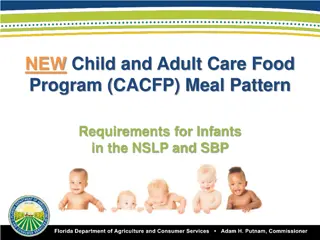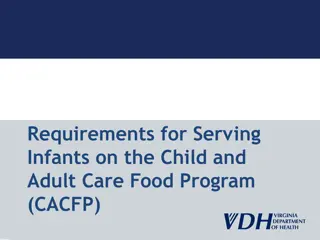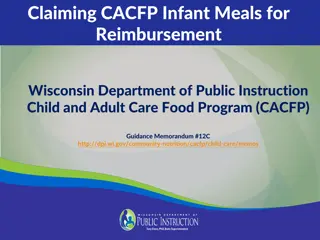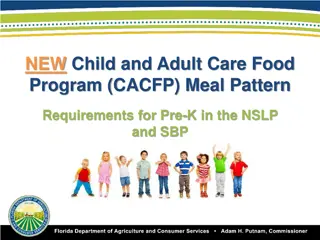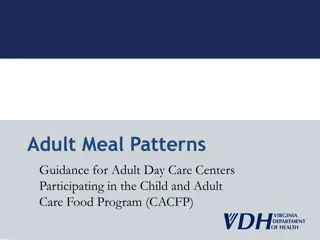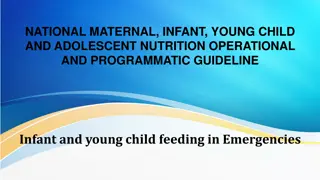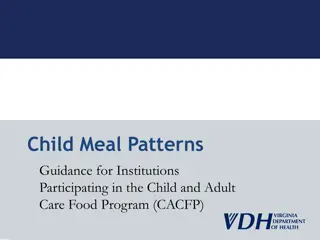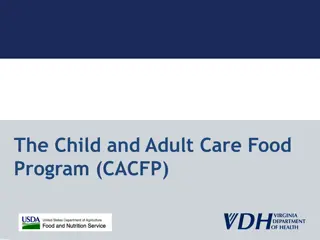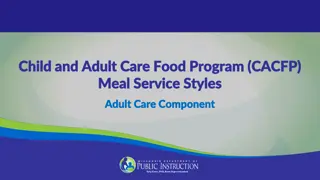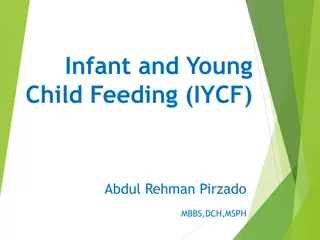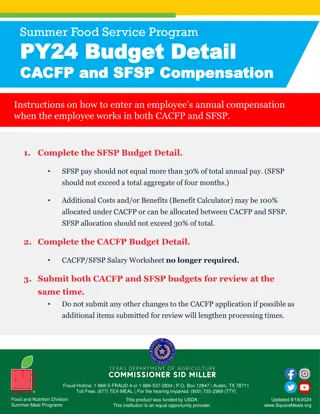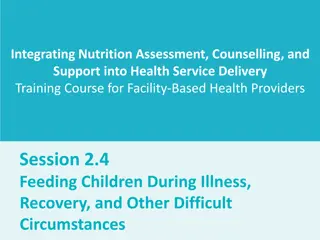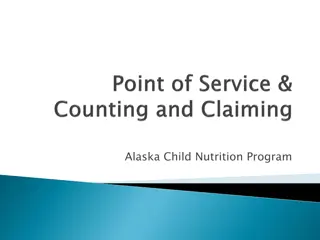CACFP Infant Feeding Meal Pattern Requirements Training Overview
The training material covers the Child and Adult Meal Pattern Requirements, emphasizing a wider variety of protein options, more fruits and vegetables, whole grains, and less added sugar and saturated fat. It details the Infant Meal Pattern Requirements, encouraging breastfeeding and promoting developmental readiness by delaying solid food introduction until around 6 months. The program allows more nutritious foods to be served when infants are developmentally ready.
Download Presentation

Please find below an Image/Link to download the presentation.
The content on the website is provided AS IS for your information and personal use only. It may not be sold, licensed, or shared on other websites without obtaining consent from the author. Download presentation by click this link. If you encounter any issues during the download, it is possible that the publisher has removed the file from their server.
E N D
Presentation Transcript
Welcome to the CACFP Meal Pattern Requirements Training Infant Feeding
Training Materials www.theicn.org/cacfpmp
Child & Adult Meal Pattern Requirements Overview Wider varieties of protein options Greater varieties of vegetables and fruits More whole grains Less added sugar and saturated fat
Infant Meal Pattern Requirements
Infant Meal Pattern Requirements Overview Meals are reimbursable when a mother breastfeeds on-site Features two age groups: Birth-5 months & 6-11 months Provides more nutritious meals and snacks o Vegetables & fruits must be served at snack o Juice, cheese food, or cheese spread are no longer creditable o Yogurt & whole eggs are allowable meat alternates
Infant Meal Pattern Age Groups PREVIOUS Birth-3 months UPDATED Birth-5 months 4-7 months 6-11 months 8-11 months
Encourages Breastfeeding Breast milk is the optimal source of nutrients Birth through the end of 5 months o Breastmilk or infant formula is the only meal component required o Minimum serving size is 4-6 oz of breastmilk (or infant formula)
Promotes Developmental Readiness Delay the introduction of solid foods until around 6 months Most infants are not ready to consume solid foods until midway through the 1st year Introducing solid foods too soon increases risk of obesity
Allows More Nutritious Foods Foods from all food components may be served around 6 months, when developmentally ready Breakfast, Lunch, & Supper o Breastmilk or iron-fortified infant formula o Infant cereal, meat/meat alternates, or a combination of both o Vegetable or fruit, or a combination of both Snack o Breastmilk or iron-fortified infant formula o Grains o Vegetable or fruit, or a combination of both
Focuses on Serving Sizes Food components beginning with zero o Recognizes that all infants are not ready for solid foods at 6 months By 7 or 8 months, infants should be consuming solid foods from all food groups
Focuses on Eating Habits Recognizes eating habits may change o Some infants may eat certain foods one week/day, but not the next o Meals & snacks consistent with eating habits should not be disallowed
Breast Milk & Infant Formula
Breastmilk & Infants Promote breastfeeding by allowing reimbursement when: o a parent/guardian supplies expressed milk Milk that is produced and expelled from the breast o a mother breastfeeds her infant on-site
Documenting On-site Breastfeeding Recording the total amount a mother breastfeeds her infant is not required Acceptable ways to document: o Breastfed on-site o Mother on-site May use existing forms to reduce paperwork
Serving Expressed Milk Breastfed infants may not consume the entire serving Reimbursable: o Offer less than the minimum serving size of breastmilk o Offer additional breastmilk later, if infant will consume more Feed on demand
Iron-Fortified Infant Formula Best supplement for breastmilk Supports healthy brain development & growth Reimbursable meals may include: o Iron-fortified formula o Breastmilk o Combination of both
Supplying Formula Offer a minimum of 1 type of iron- fortified infant formula Formula must be regulated by FDA o May not credit if purchased outside U.S.
Serving Formula Infants may not drink the entire serving of formula o Reimbursable as long as the minimum serving size is offered Any leftovers should be properly stored in accordance with local health and safety requirements Feed on demand
Disabilities & Substitutions Modifications must be made for infants with disabilities who need accommodations A medical statement must be on file to receive reimbursement o Explain the need for the modification o Provide guidance for the substitution or meal modification
Fruits & Vegetables
Vegetables & Fruits Great source of essential nutrients o i.e., fiber & vitamin C Minimum serving size: 0-2 tbsp. Required at all meals & snacks o Serve vegetable, fruit, or a combination of both o Increases consumption & allows for better acceptance later in life
Juice Lacks dietary fiber found in other forms of fruits & vegetables No longer credits toward a reimbursable meal for infants
Meat/Meat Alternates Poultry & other meats Yogurt Cheese Whole Eggs Dry beans
Yogurt Great source of protein Minimum serving size: 0-4 oz Maybe served during breakfast, lunch, or supper Must meet the new sugar requirements
Whole Eggs AAP found no convincing evidence to delay foods considered major food allergens Whole eggs are now creditable for infant meals Minimum serving size: 0-4 tbsp.
Cheese Minimum serving size: 0-2 oz Cheese & cottage cheese Common examples o Shredded or sliced Swiss, Colby, & Monterey Jack
Cheese foods & cheese spreads are disallowed for infant meals & snacks
Non-Creditable Cheese Foods Product packaging states: o Imitation cheese o Cheese food o Cheese product Common items o Cheese whips o Cheese with pimento o Cream cheese
Grains & Infant Cereal
Grains & Infant Cereals Iron-fortified infant cereals are often the first solid foods: o Often easiest to digest o Least likely to cause an allergic reaction Serve at meals & snacks when infants are developmentally ready Minimum serving size: 0-4 tbsp.
Snack Meals Only Bread, crackers, & ready-to-eat breakfast cereals Ready-to-eat breakfast cereals: No more than 6 grams of sugar per dry oz
Developmental Readiness
Developmental Readiness Introducing solid foods too early: o cause choking o consume less breastmilk or formula Serve solid foods when infants are developmentally ready
American Academy of Pediatrics Developmental Readiness Guidelines Sits in chair with good head control Opens mouth for food Moves food from a spoon into throat Doubles in birth weight
Parent Communication Working with parents helps to o Ensure newly introduced foods are most ideal o Be consistent with eating habits o Support developmental readiness Always consult with parents/guardians first before serving solid foods
Optional Written Statement Request a written statement from parents or guardians: o outlining when & which solid foods to serve Follows the preferences of parents & guardians
Providing Food Components Parents/guardians may provide only one creditable food component for a reimbursable meal o i.e., provide breastmilk = 1 component Child care providers must provide remaining components
Introducing Solid Food(s) Once an infant shows signs of developmental readiness, solid foods must be offered Gradually introduce solid foods o One at a time o Over the course of a few days
Introducing Solid Food(s) (cont.) Prepare foods in the right texture and consistency Observe infants closely for reactions after feeding a new food
Optional Best Practices
Best Practices & the CACFP Designed to further improve the nutritional quality of all meals Optional, but highly encouraged o Ensures children & adults get optimal benefits from meals Non-compliance does not cause: o Meal disallowance o Serious deficiency finding
Infants Support mothers who choose to breastfeed o Encourage mothers to supply breastmilk o Provide a quiet, private area, that is comfortable, safe, & sanitary
Best Practices Action Plan Builds on the meal pattern requirements Shows your commitment to those in your care Establish & implement a plan
Documenting Compliance
Sample Infant Documentation Individual by infant Includes the infant s name and date of birth Documents the amount of food offered at each meal period Includes specific information on the food items served (i.e. applesauce vs. fruit ) Denotes any parent-provided meal components Is maintained on site at the center for at least 3 years plus the current year


